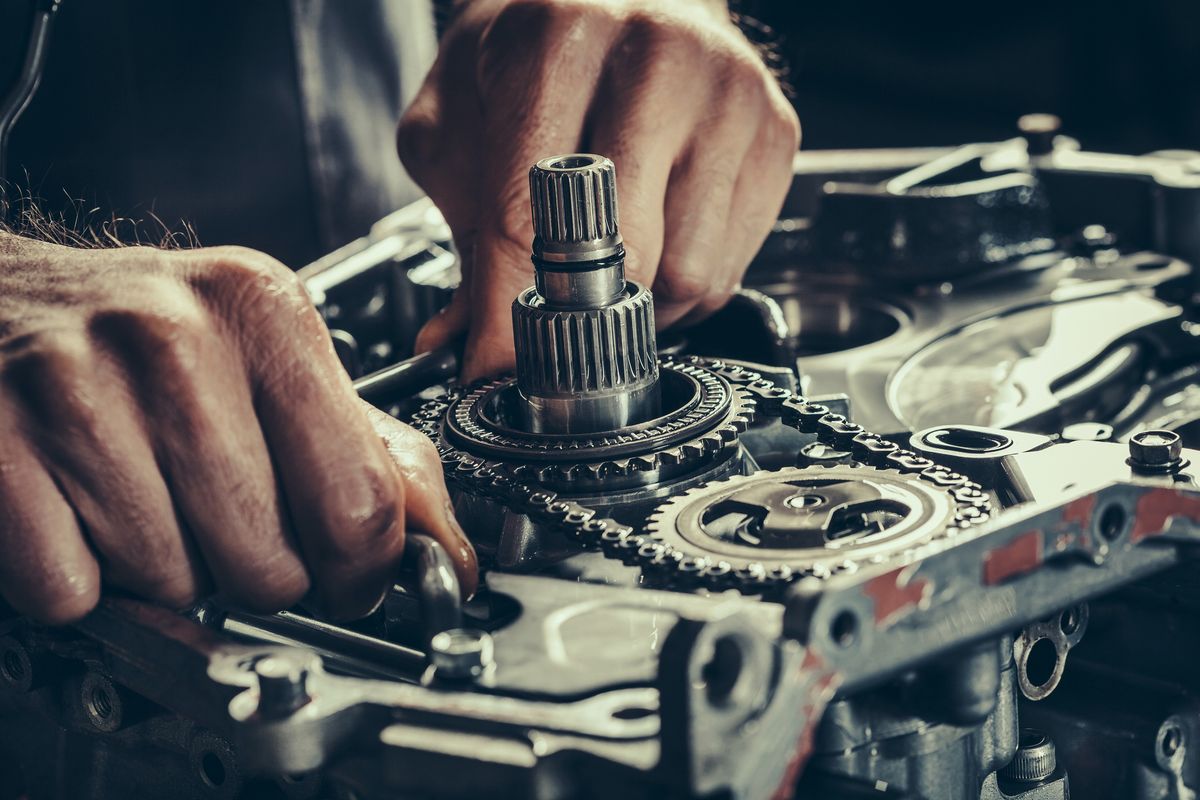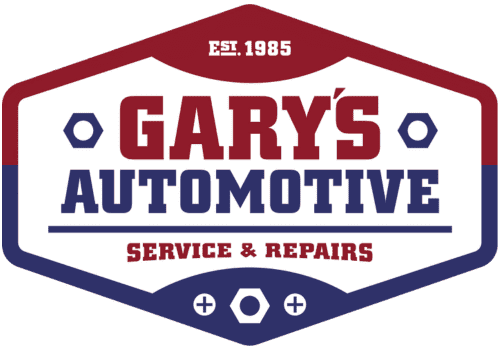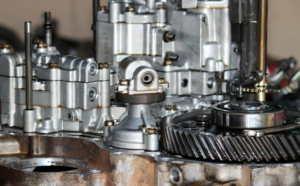
Car Transmissions: Explained by Gary’s Automotive in Langley
At a fundamental level, a car’s transmission resembles a sophisticated bicycle’s gear system. It’s akin to the chain and shifter setup we see in our two-wheel companions. However, the transmission in your Ford Mustang or Toyota Corolla is undeniably more intricate. Situated intimately with the engine, it uses belts and chains to turn engine power into the force that gets your car moving on the streets of Langley and throughout the Fraser Valley.
How Engines Set the Stage in Greater Vancouver Rides
To grasp the importance of transmissions, let’s first understand what happens under the hood of, say, a Honda Civic:
- Fuel, often gasoline, ignites in the combustion chamber.
- This ignition pushes pistons in the engine’s cylinders with an explosion of gas and heat.
- Pistons move, turning the engine’s crankshaft.
- The crankshaft then gives energy to the drive wheels, morphing explosive energy into physical motion.
Gary’s Automotive Explains: Why Transmissions Matter in the Lower Mainland
Without a transmission, imagine the raw power of your BMW‘s engine going unregulated. Controlling speed, starting, or stopping around Greater Vancouver would be a nightmare. This is where transmissions, full of gears, come into play. They dictate the power going to the wheels without tampering with the engine’s speed.
In essence, a transmission ensures your Chevrolet Silverado operates at its peak in the Fraser Valley. Whether cruising or stopping, it ensures the power transfer is just right.
Why Langley Mechanics Stress on Transmission Care
A well-maintained transmission, whether checked by Gary’s Automotive or another reputable auto repair shop in Langley, plays several pivotal roles:
Safety and Durability: Without it, engines could run at harmful speeds, risking damage.
Maintaining Speed: Based on how fast you’re driving your Audi A3 or the pressure on the accelerator, transmissions maintain the engine’s RPM.
Fuel Efficiency: A well-tuned transmission can help your Volkswagen Golf achieve better mileage by optimizing RPMs.
Power Control: It helps in distributing engine power, for instance, giving a Dodge Ram the push needed for uphill tasks or a smooth highway drive.
Deciphering Manual vs. Automatic: Gary’s Automotive Insight
Stick Shifts or Manual Transmissions
The stick shift, traditionally known as the manual transmission, stands as the pioneer in the realm of transmissions. Sometimes referred to as the standard transmission, it primarily involves the driver using a clutch pedal to regulate the torque flowing from the engine to the transmission, while also manually switching gears.
In terms of structure, manual transmissions often boast a simpler design, which can lead to a longer lifespan due to fewer components at risk of malfunction. However, the main challenge associated with them is the hands-on learning they demand. Driving a vehicle with a stick shift requires enhanced attention and skills, differentiating it from other transmission types.
Automatic Gear Systems or Automatic Transmissions
While stick shifts are recognized for their straightforward mechanics, they can be challenging to handle. For those who prefer a more hassle-free driving experience, the automatic transmission is the go-to choice. In vehicles equipped with this system, gear changes are autonomously managed as the car progresses, allowing the driver to concentrate solely on navigating the road.
If you’ve ever noticed your engine’s pitch rising before suddenly dropping as you pick up speed, that’s an indication of your vehicle transitioning from a lower to an upper gear. Most modern automatic systems come equipped with five to ten gears. A higher number of gears ensures a more diverse speed range at which the car can deliver its best performance, often translating to enhanced fuel efficiency.
However, the convenience of automatic transmissions does come at a cost. Their intricate design makes them more susceptible to wear and tear. Consequently, should an issue arise, repairs or replacements for these systems can be quite heavy on the pocket.
Delving Deeper into Transmissions: Insights from our Langley Mechanic
The principle is common across both manual and automatic transmissions:
Choosing Gears: A gear lever helps in selecting the required gear.
Engaging the Clutch: In manual transmissions, drivers disconnect the engine from the transmission during gear changes. Automatics use sensors to manage this.
Gearing Up: Clutch plates or “collar” plates connect with the main gears, which then connect to the car’s differential, ensuring your Subaru Outback runs smoothly on the lower mainland roads.
Misalignment Noises: What’s That Sound in your Ford F-150?
Ever heard a grinding sound while changing gears? It’s not the gears but the mismatch of the collar plate’s “dog teeth”. Gary’s Automotive recommends regular auto repair checks to ensure smooth gear transitions, especially if you drive around Fraser Valley frequently.
Wrapping It Up: The Central Role of Transmissions
Car transmissions, be it in your elegant LandRover or reliable Subaru, are essential for smooth driving in and around Langley. These complex systems ensure your drive is seamless, whether you’re cruising through the lower mainland or commuting in Greater Vancouver. Remember, when in need of related services or a trusted mechanic in Langley, Gary’s Automotive is here to assist.

How other parts of your car affect transmission
AIR CONDITIONING The transmission’s efficiency can be indirectly affected by the air conditioning system. When the AC system is engaged, it demands power from the engine, which can in turn influence the transmission’s workload, especially when driving at low speeds or idling.
BRAKES Brakes and transmissions work hand in hand. If the brakes aren’t functioning optimally, it can cause undue stress on the transmission, especially when downshifting or engine braking is used as a supplementary method to reduce speed.
DIAGNOSTICS Transmission diagnostics are crucial for identifying issues before they become significant problems. Specialist diagnostic tests can reveal whether parts of the transmission are wearing out or if there are any software issues affecting its performance.
ELECTRICAL Modern transmissions, especially automatic ones, rely on electrical components and sensors for optimal operation. Faulty electrical systems can lead to erratic gear shifts or even complete transmission failure.
EXHAUST AND MUFFLERS The efficiency of the exhaust system can impact engine performance, which in turn, affects the transmission. For instance, a clogged exhaust can choke the engine, affecting the power available for the transmission to do its job.
ENGINES The engine and transmission are like dance partners. If one is off-beat, the other suffers. A well-maintained engine ensures that the transmission receives consistent power for smooth gear transitions.
TIRES Mismatched or worn-out tires can lead to uneven power distribution from the transmission, causing it to work harder to balance the vehicle’s movement, which might lead to premature wear.
FLUID MAINTENANCE Transmission fluid is the lifeblood of the system, ensuring smooth gear shifts. Regular fluid maintenance is essential to prevent overheating and to ensure components stay lubricated.
DIESEL Diesel engines typically produce more torque than their gasoline counterparts. As such, transmissions in diesel vehicles are designed to handle this increased torque and require specialized maintenance to ensure longevity.
FLEET MAINTENANCE For fleet vehicles that often see more use and wear than private cars, it’s crucial to maintain transmissions regularly. Consistent heavy loads or constant starting and stopping can strain transmissions.
CUSTOM EXHAUST SYSTEMS While primarily affecting engine performance, custom exhaust systems can indirectly influence transmissions. An efficient exhaust can provide the engine with better airflow, leading to improved power delivery to the transmission. There are also lots of great benefits to a custom exhaust.


